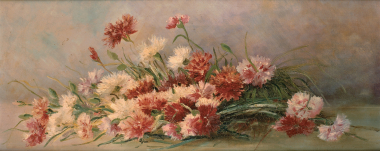The first steps

The First Steps is among Iakovidis's most important works. It must have been produced around 1889, a time marked by a change of direction in his painting as regards the stylistic rendering of the subject through the dominant role of light, as that took shape in Germany in the late nineteenth century. A comparison with the work of the same title in the National Gallery gives the measure of these changes, as in the work in the Averoff Gallery, he tentatively attempts solutions which were to take a more specific direction in the decade which followed. The light which enters the room is diffused throughout the whole space, lending particular brilliance to the points on which it falls (on the baby, the head and the tip of the hand of the girl), tracing the outlines, while the chiaroscuro accurately models the details of the faces, the clothing, and the furniture. This handling was to lead Iakovidis to a freer and more luminous form of painting which would link him with the more progressive painters of Germany, the so-called German Impressionists.







